Abstract
The effect of electrically induced muscle contraction, insulin (10 m-units/ml) and electrically-induced muscle contraction in the presence of insulin on insulin-regulatable glucose-transporter (GLUT-4) protein distribution was studied in female Sprague-Dawley rats during hindlimb perfusion. Plasma-membrane cytochalasin B binding increased approximately 2-fold, whereas GLUT-4 protein concentration increased approximately 1.5-fold above control with contractions, insulin, or insulin + contraction. Microsomal-membrane cytochalasin B binding and GLUT-4 protein concentration decreased by approx. 30% with insulin or insulin + contraction, but did not significantly decrease with contraction alone. The rate of muscle glucose uptake was assessed by determining the rate of 2-deoxy[3H]glucose accumulation in the soleus, plantaris, and red and white portions of the gastrocnemius. Both contraction and insulin increased glucose uptake significantly and to the same degree in the muscles examined. Insulin + contraction increased glucose uptake above that of insulin or contraction alone, but this effect was only statistically significant in the soleus, plantaris and white gastrocnemius. The combined effects of insulin + contraction of glucose uptake were not fully additive in any of the muscles investigated. These results suggest that (1) insulin and muscle contraction are mobilizing two separate pools of GLUT-4 protein, and (2) the increase in skeletal-muscle glucose uptake due to insulin + contraction is not due to an increase in plasma-membrane GLUT-4 protein concentration above that observed for insulin or contraction alone.
Full text
PDF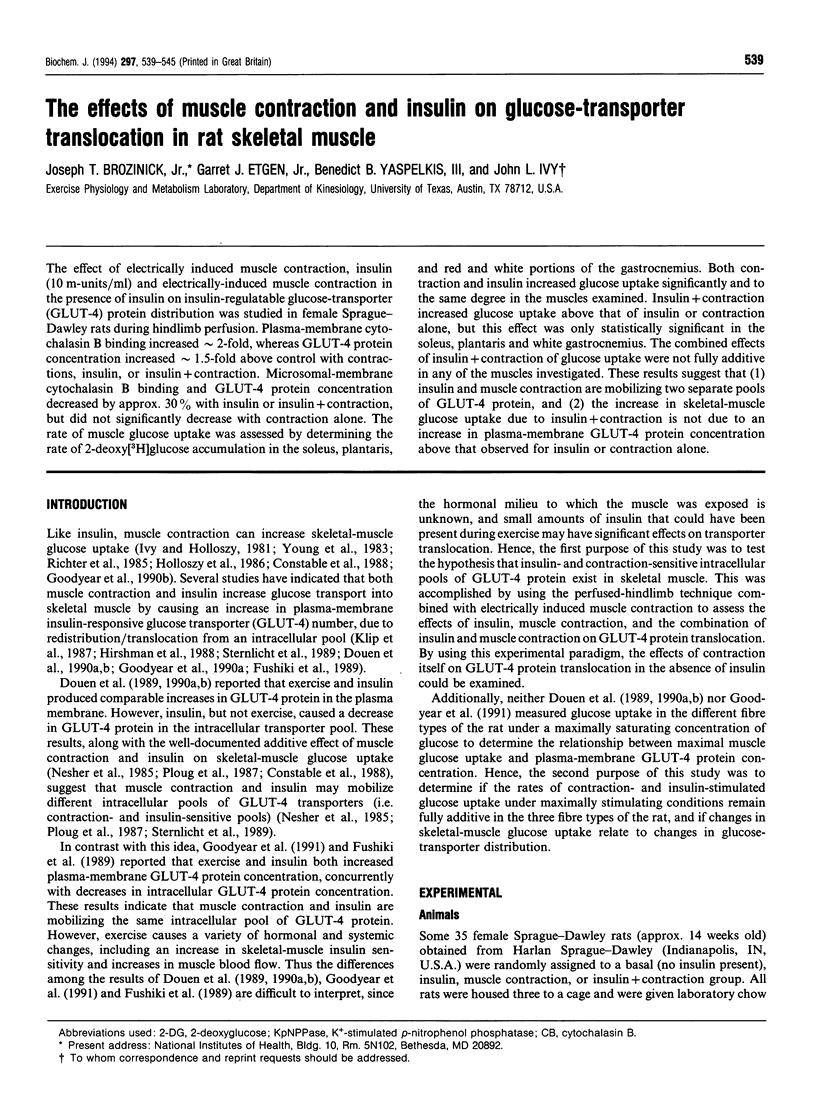
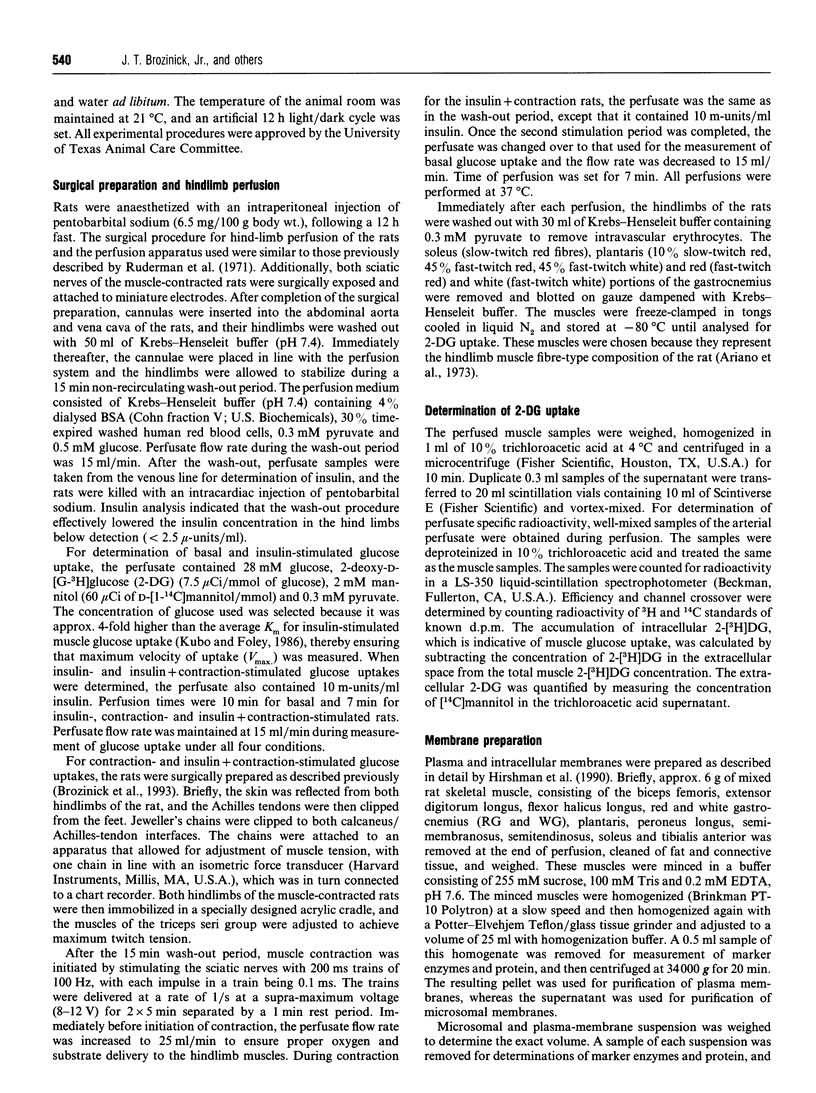
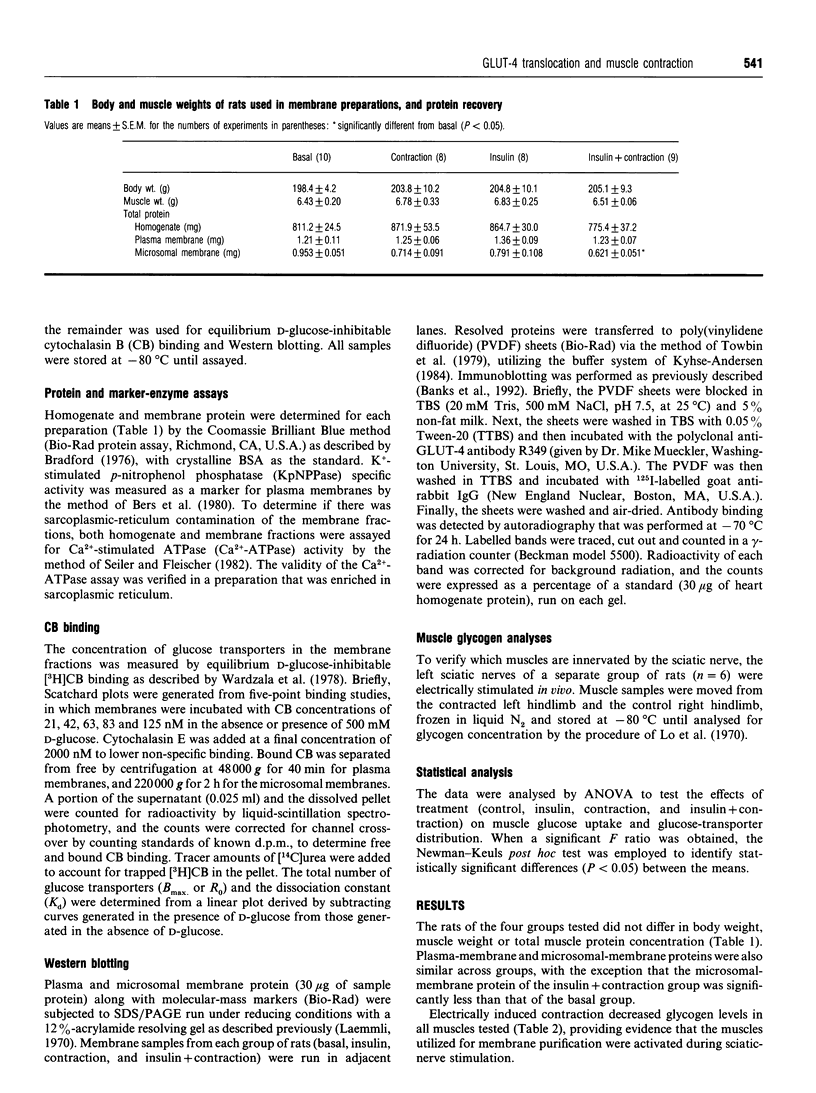
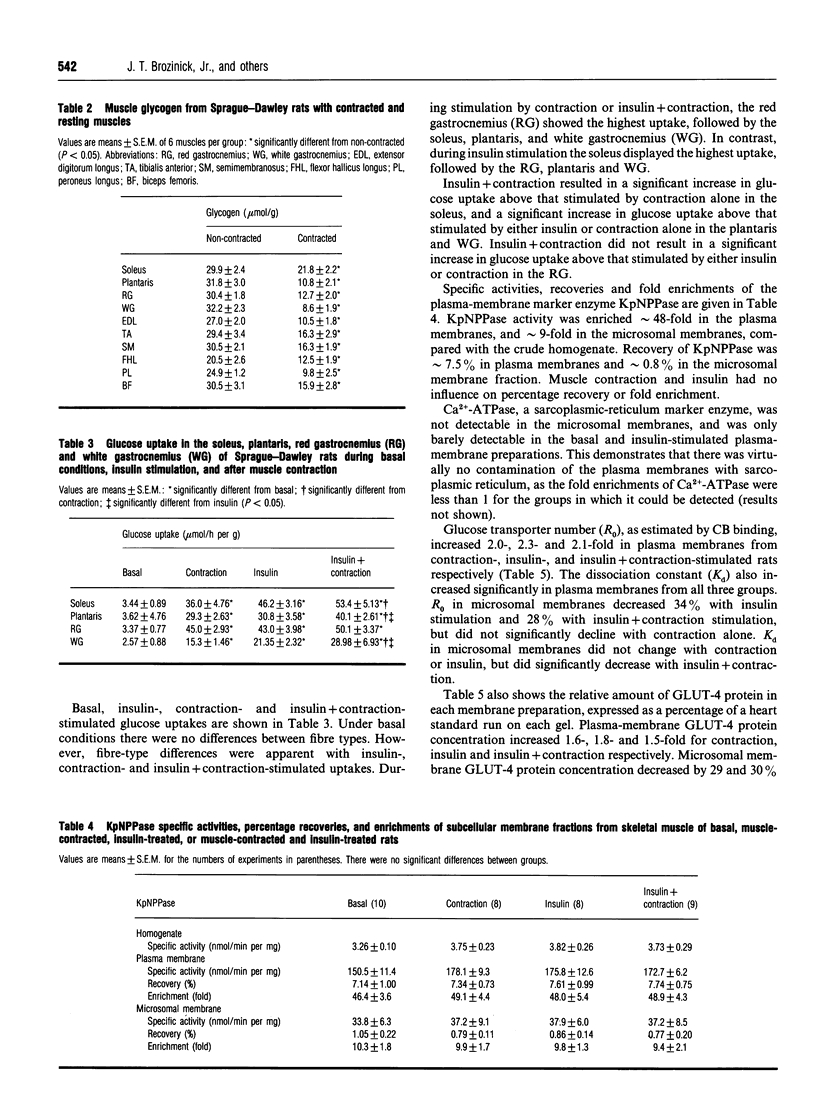
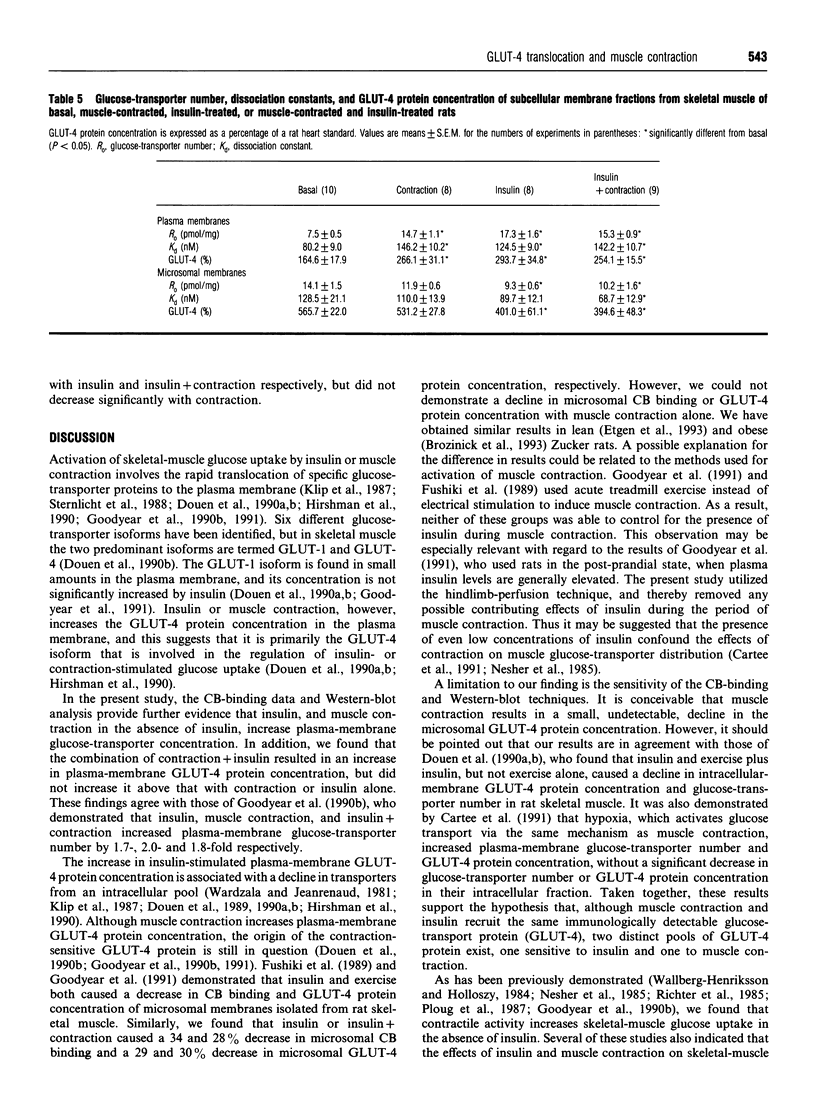
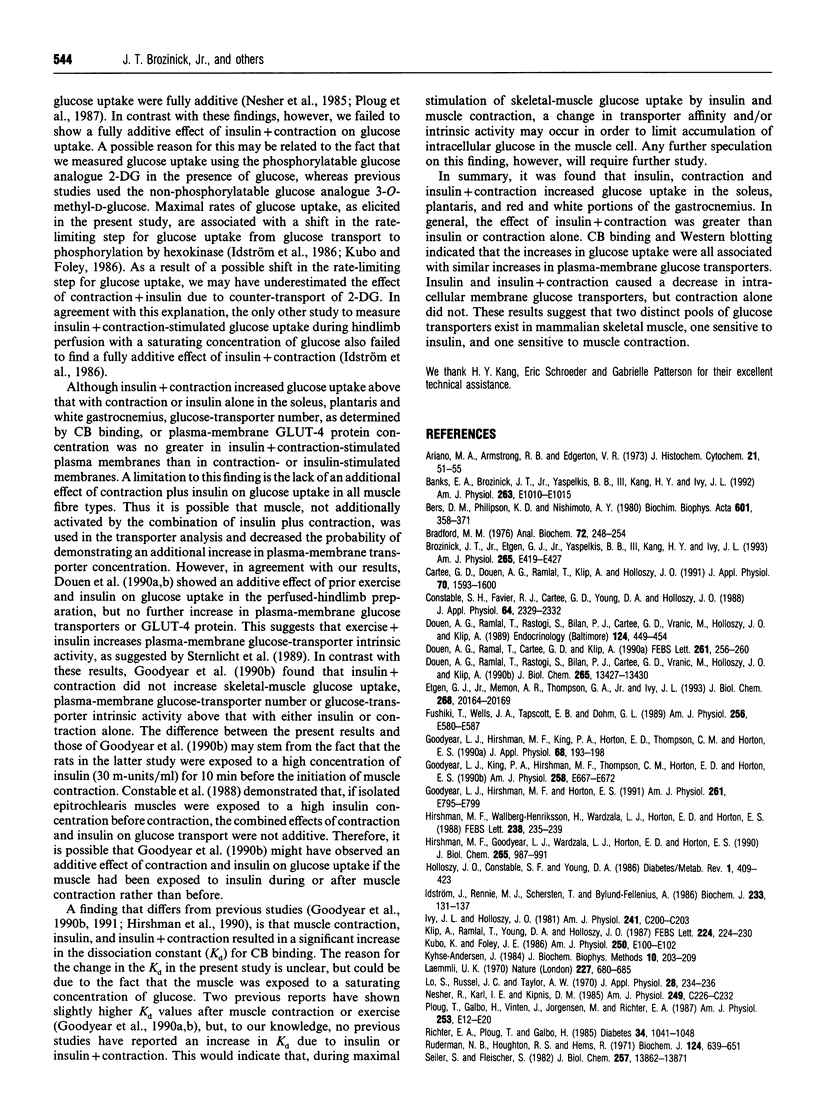
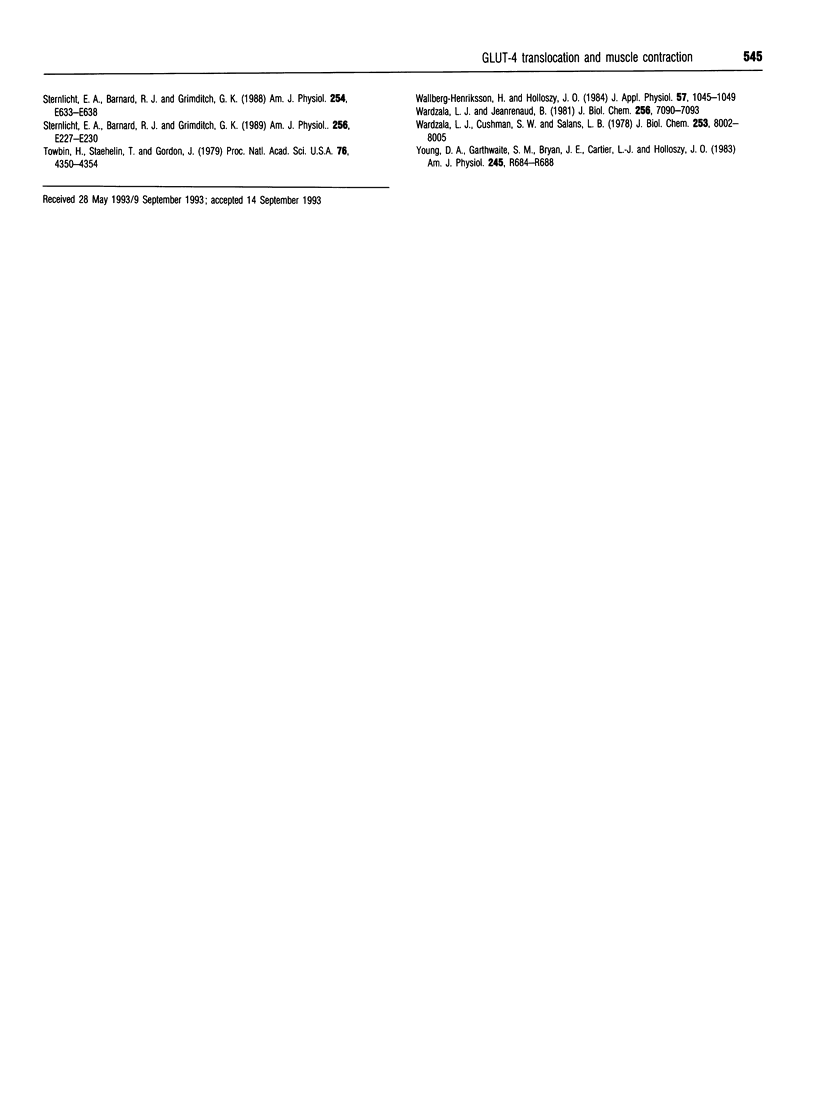
Selected References
These references are in PubMed. This may not be the complete list of references from this article.
- Ariano M. A., Armstrong R. B., Edgerton V. R. Hindlimb muscle fiber populations of five mammals. J Histochem Cytochem. 1973 Jan;21(1):51–55. doi: 10.1177/21.1.51. [DOI] [PubMed] [Google Scholar]
- Banks E. A., Brozinick J. T., Jr, Yaspelkis B. B., 3rd, Kang H. Y., Ivy J. L. Muscle glucose transport, GLUT-4 content, and degree of exercise training in obese Zucker rats. Am J Physiol. 1992 Nov;263(5 Pt 1):E1010–E1015. doi: 10.1152/ajpendo.1992.263.5.E1015. [DOI] [PubMed] [Google Scholar]
- Bers D. M., Philipson K. D., Nishimoto A. Y. Sodium-calcium exchange and sidedness of isolated cardiac sarcolemmal vesicles. Biochim Biophys Acta. 1980 Sep 18;601(2):358–371. doi: 10.1016/0005-2736(80)90540-4. [DOI] [PubMed] [Google Scholar]
- Bradford M. M. A rapid and sensitive method for the quantitation of microgram quantities of protein utilizing the principle of protein-dye binding. Anal Biochem. 1976 May 7;72:248–254. doi: 10.1016/0003-2697(76)90527-3. [DOI] [PubMed] [Google Scholar]
- Brozinick J. T., Jr, Etgen G. J., Jr, Yaspelkis B. B., 3rd, Kang H. Y., Ivy J. L. Effects of exercise training on muscle GLUT-4 protein content and translocation in obese Zucker rats. Am J Physiol. 1993 Sep;265(3 Pt 1):E419–E427. doi: 10.1152/ajpendo.1993.265.3.E419. [DOI] [PubMed] [Google Scholar]
- Cartee G. D., Douen A. G., Ramlal T., Klip A., Holloszy J. O. Stimulation of glucose transport in skeletal muscle by hypoxia. J Appl Physiol (1985) 1991 Apr;70(4):1593–1600. doi: 10.1152/jappl.1991.70.4.1593. [DOI] [PubMed] [Google Scholar]
- Constable S. H., Favier R. J., Cartee G. D., Young D. A., Holloszy J. O. Muscle glucose transport: interactions of in vitro contractions, insulin, and exercise. J Appl Physiol (1985) 1988 Jun;64(6):2329–2332. doi: 10.1152/jappl.1988.64.6.2329. [DOI] [PubMed] [Google Scholar]
- Douen A. G., Ramlal T., Cartee G. D., Klip A. Exercise modulates the insulin-induced translocation of glucose transporters in rat skeletal muscle. FEBS Lett. 1990 Feb 26;261(2):256–260. doi: 10.1016/0014-5793(90)80566-2. [DOI] [PubMed] [Google Scholar]
- Douen A. G., Ramlal T., Klip A., Young D. A., Cartee G. D., Holloszy J. O. Exercise-induced increase in glucose transporters in plasma membranes of rat skeletal muscle. Endocrinology. 1989 Jan;124(1):449–454. doi: 10.1210/endo-124-1-449. [DOI] [PubMed] [Google Scholar]
- Douen A. G., Ramlal T., Rastogi S., Bilan P. J., Cartee G. D., Vranic M., Holloszy J. O., Klip A. Exercise induces recruitment of the "insulin-responsive glucose transporter". Evidence for distinct intracellular insulin- and exercise-recruitable transporter pools in skeletal muscle. J Biol Chem. 1990 Aug 15;265(23):13427–13430. [PubMed] [Google Scholar]
- Etgen G. J., Jr, Memon A. R., Thompson G. A., Jr, Ivy J. L. Insulin- and contraction-stimulated translocation of GTP-binding proteins and GLUT4 protein in skeletal muscle. J Biol Chem. 1993 Sep 25;268(27):20164–20169. [PubMed] [Google Scholar]
- Fushiki T., Wells J. A., Tapscott E. B., Dohm G. L. Changes in glucose transporters in muscle in response to exercise. Am J Physiol. 1989 May;256(5 Pt 1):E580–E587. doi: 10.1152/ajpendo.1989.256.5.E580. [DOI] [PubMed] [Google Scholar]
- Goodyear L. J., Hirshman M. F., Horton E. S. Exercise-induced translocation of skeletal muscle glucose transporters. Am J Physiol. 1991 Dec;261(6 Pt 1):E795–E799. doi: 10.1152/ajpendo.1991.261.6.E795. [DOI] [PubMed] [Google Scholar]
- Goodyear L. J., Hirshman M. F., King P. A., Horton E. D., Thompson C. M., Horton E. S. Skeletal muscle plasma membrane glucose transport and glucose transporters after exercise. J Appl Physiol (1985) 1990 Jan;68(1):193–198. doi: 10.1152/jappl.1990.68.1.193. [DOI] [PubMed] [Google Scholar]
- Goodyear L. J., King P. A., Hirshman M. F., Thompson C. M., Horton E. D., Horton E. S. Contractile activity increases plasma membrane glucose transporters in absence of insulin. Am J Physiol. 1990 Apr;258(4 Pt 1):E667–E672. doi: 10.1152/ajpendo.1990.258.4.E667. [DOI] [PubMed] [Google Scholar]
- Hirshman M. F., Goodyear L. J., Wardzala L. J., Horton E. D., Horton E. S. Identification of an intracellular pool of glucose transporters from basal and insulin-stimulated rat skeletal muscle. J Biol Chem. 1990 Jan 15;265(2):987–991. [PubMed] [Google Scholar]
- Hirshman M. F., Wallberg-Henriksson H., Wardzala L. J., Horton E. D., Horton E. S. Acute exercise increases the number of plasma membrane glucose transporters in rat skeletal muscle. FEBS Lett. 1988 Oct 10;238(2):235–239. doi: 10.1016/0014-5793(88)80486-1. [DOI] [PubMed] [Google Scholar]
- Holloszy J. O., Constable S. H., Young D. A. Activation of glucose transport in muscle by exercise. Diabetes Metab Rev. 1986;1(4):409–423. doi: 10.1002/dmr.5610010405. [DOI] [PubMed] [Google Scholar]
- Idström J. P., Rennie M. J., Scherstén T., Bylund-Fellenius A. C. Membrane transport in relation to net uptake of glucose in the perfused rat hindlimb. Stimulatory effect of insulin, hypoxia and contractile activity. Biochem J. 1986 Jan 1;233(1):131–137. doi: 10.1042/bj2330131. [DOI] [PMC free article] [PubMed] [Google Scholar]
- Ivy J. L., Holloszy J. O. Persistent increase in glucose uptake by rat skeletal muscle following exercise. Am J Physiol. 1981 Nov;241(5):C200–C203. doi: 10.1152/ajpcell.1981.241.5.C200. [DOI] [PubMed] [Google Scholar]
- Klip A., Ramlal T., Young D. A., Holloszy J. O. Insulin-induced translocation of glucose transporters in rat hindlimb muscles. FEBS Lett. 1987 Nov 16;224(1):224–230. doi: 10.1016/0014-5793(87)80452-0. [DOI] [PubMed] [Google Scholar]
- Kubo K., Foley J. E. Rate-limiting steps for insulin-mediated glucose uptake into perfused rat hindlimb. Am J Physiol. 1986 Jan;250(1 Pt 1):E100–E102. doi: 10.1152/ajpendo.1986.250.1.E100. [DOI] [PubMed] [Google Scholar]
- Kyhse-Andersen J. Electroblotting of multiple gels: a simple apparatus without buffer tank for rapid transfer of proteins from polyacrylamide to nitrocellulose. J Biochem Biophys Methods. 1984 Dec;10(3-4):203–209. doi: 10.1016/0165-022x(84)90040-x. [DOI] [PubMed] [Google Scholar]
- Laemmli U. K. Cleavage of structural proteins during the assembly of the head of bacteriophage T4. Nature. 1970 Aug 15;227(5259):680–685. doi: 10.1038/227680a0. [DOI] [PubMed] [Google Scholar]
- Lo S., Russell J. C., Taylor A. W. Determination of glycogen in small tissue samples. J Appl Physiol. 1970 Feb;28(2):234–236. doi: 10.1152/jappl.1970.28.2.234. [DOI] [PubMed] [Google Scholar]
- Nesher R., Karl I. E., Kipnis D. M. Dissociation of effects of insulin and contraction on glucose transport in rat epitrochlearis muscle. Am J Physiol. 1985 Sep;249(3 Pt 1):C226–C232. doi: 10.1152/ajpcell.1985.249.3.C226. [DOI] [PubMed] [Google Scholar]
- Ploug T., Galbo H., Vinten J., Jørgensen M., Richter E. A. Kinetics of glucose transport in rat muscle: effects of insulin and contractions. Am J Physiol. 1987 Jul;253(1 Pt 1):E12–E20. doi: 10.1152/ajpendo.1987.253.1.E12. [DOI] [PubMed] [Google Scholar]
- Richter E. A., Ploug T., Galbo H. Increased muscle glucose uptake after exercise. No need for insulin during exercise. Diabetes. 1985 Oct;34(10):1041–1048. doi: 10.2337/diab.34.10.1041. [DOI] [PubMed] [Google Scholar]
- Ruderman N. B., Houghton C. R., Hems R. Evaluation of the isolated perfused rat hindquarter for the study of muscle metabolism. Biochem J. 1971 Sep;124(3):639–651. doi: 10.1042/bj1240639. [DOI] [PMC free article] [PubMed] [Google Scholar]
- Seiler S., Fleischer S. Isolation of plasma membrane vesicles from rabbit skeletal muscle and their use in ion transport studies. J Biol Chem. 1982 Nov 25;257(22):13862–13871. [PubMed] [Google Scholar]
- Sternlicht E., Barnard R. J., Grimditch G. K. Exercise and insulin stimulate skeletal muscle glucose transport through different mechanisms. Am J Physiol. 1989 Feb;256(2 Pt 1):E227–E230. doi: 10.1152/ajpendo.1989.256.2.E227. [DOI] [PubMed] [Google Scholar]
- Sternlicht E., Barnard R. J., Grimditch G. K. Mechanism of insulin action on glucose transport in rat skeletal muscle. Am J Physiol. 1988 May;254(5 Pt 1):E633–E638. doi: 10.1152/ajpendo.1988.254.5.E633. [DOI] [PubMed] [Google Scholar]
- Towbin H., Staehelin T., Gordon J. Electrophoretic transfer of proteins from polyacrylamide gels to nitrocellulose sheets: procedure and some applications. Proc Natl Acad Sci U S A. 1979 Sep;76(9):4350–4354. doi: 10.1073/pnas.76.9.4350. [DOI] [PMC free article] [PubMed] [Google Scholar]
- Wallberg-Henriksson H., Holloszy J. O. Contractile activity increases glucose uptake by muscle in severely diabetic rats. J Appl Physiol Respir Environ Exerc Physiol. 1984 Oct;57(4):1045–1049. doi: 10.1152/jappl.1984.57.4.1045. [DOI] [PubMed] [Google Scholar]
- Wardzala L. J., Cushman S. W., Salans L. B. Mechanism of insulin action on glucose transport in the isolated rat adipose cell. Enhancement of the number of functional transport systems. J Biol Chem. 1978 Nov 25;253(22):8002–8005. [PubMed] [Google Scholar]
- Wardzala L. J., Jeanrenaud B. Potential mechanism of insulin action on glucose transport in the isolated rat diaphragm. Apparent translocation of intracellular transport units to the plasma membrane. J Biol Chem. 1981 Jul 25;256(14):7090–7093. [PubMed] [Google Scholar]
- Young J. C., Garthwaite S. M., Bryan J. E., Cartier L. J., Holloszy J. O. Carbohydrate feeding speeds reversal of enhanced glucose uptake in muscle after exercise. Am J Physiol. 1983 Nov;245(5 Pt 1):R684–R688. doi: 10.1152/ajpregu.1983.245.5.R684. [DOI] [PubMed] [Google Scholar]


